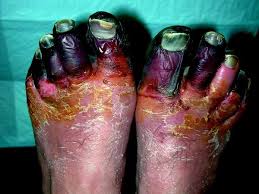A Case Study for Frostbite Treatment
A case study a 50yr old male who suffered severe frostbite.
While working at Deer Valley Ski Resort in Ogden, Utah Russell had been out all morning on a very cold 22 below zero mountainside. “We took a break at lunch to rest, eat and get out of the cold and I knew I was cold but didn’t realize just how cold I was until I took my boots off,” said Russell. “When I took my boots off, my toes had already begun turning white and blistering due to frostbite. A day later they turned black and the flesh began peeling off my toes.”
The culprit? Frostbite. Frostbite occurs when damage is caused to skin and other tissues due to exposure to freezing temperatures. It is most likely to affect body parts farthest from the heart and those with large exposed areas.
A 1996 study showed that more than 1.2 million people in the United States are living with limb loss due to frostbite. The prevalence rate was 4.9 per 1,000 people. Russell didn’t want to be another one of the statistics.
Russell was treated for frostbite and had to take some time away from the slopes but by the next season was back on the slopes teaching again. All went well until he suffered another case of frostbite after spending 44 straight days on the slopes in Park City, Utah. This time the frostbite affected both feet, specifically his toes as well as the balls of his feet.

“I spent the next two weeks in the hospital receiving daily treatments and then when I was released I spent the next eight weeks giving myself antibiotic injections three times a day to stave off infection to my bloodstream and bones,” said Russell. “My doctor at the time, Dr. Eric Heiden a former Olympic speed skater, was concerned that I was going to end up losing some toes and possibly more of my foot. The problem was that the high amount of loss of flesh and exposure to the bones in my feet, Dr. Heiden was worried about a bone marrow infection which if I got could have possibly killed me.”
Dr. Heiden’s concerns over infection led him to refer Russell to Dr. Terri DeJohn, a wound care specialist at the University of Utah’s Hyperbolic Medicine Unit.
“I really had a minimal amount of tissue on my foot and it was darn near just exposed bone on the ball of my foot,” explained Russell. “I didn’t realize it and I don’t think most people do, but frostbite is a lot like leprosy in that your skin rots and falls off until there’s no flesh left and your bones are exposed. More often than not the skin never grows back”
“Dr. Heiden was open to my trying the product but was insistent that due to his concerns over a possible infection we didn’t have a lot of time,” continued Russell. “I was open to anything that might help save my toes and feet. Within a day of taking ProT GOLD liquid protein, I noticed that my flesh was starting to improve. In the first 24 hours, my skin started turning from black to a lighter shade closer to my normal skin color and the blistering went away.”
By this point, Russell had already visited Dr. DeJohn and was discussing an aggressive treatment strategy in the Unit’s Hyperbaric Chamber.
“Once I began taking the ProT GOLD, it worked so well I never had to do even one treatment in the hyperbolic chamber,” said Russell. “Dr. DeJohn was so impressed with how quickly the tissues on my feet grew back that she actually began recommending ProT Gold to her other patients that were suffering from similar skin and tissue issues.”